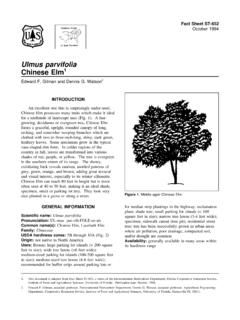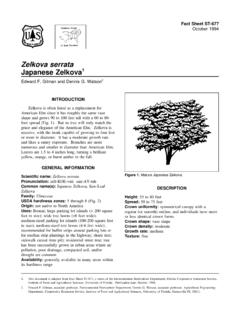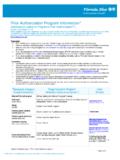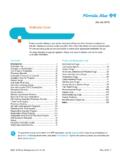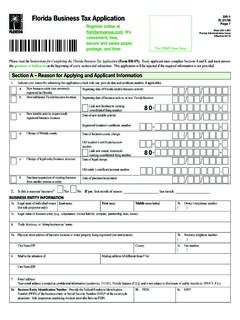Transcription of Hydrangea macrophylla - University of Florida, Institute ...
1 Do cument is Fact Sheet FPS-258, one of a series of the Environmental Horti culture Department, florida Cooperative Extension Service , Institute of Foodand Agricult ural Science s, Universit y of florida . Publication date: October, 1999 Please visit the EDIS Web sit e at Institute of Food and Agricultural Sciences is an equal opportunity/affirmative action employer authorized to provide research, educationalinformation and other services only to individuals and institutions that function without regard to race, color, sex, age, handicap, or national information on obtaining other extension publications, contact your county Cooperative Extension Service office. florida CooperativeExtension Service / Institute of Food and Agricultural Sciences / University of florida / Christine Taylor Waddill, F.
2 Gilman, professor, Environmental Horticulture Department, Cooperative Extension Service, Institute of Food and Agricultural Sciences, Universityof florida , Gainesville, 1. Bigleaf Sheet FPS-258 October, 1999 Hydrangea macrophylla1 Edward F. Gilman2 IntroductionAlmost everyone is familiar with the enormous, roundflower heads of Hydrangea , in various shades of white, pink,red, and, on acid soils, blue (Fig. 1). They are borne in latespring on top of the rounded canopy of rich foliage. The coarsegreen foliage works well as a foundation plant or accent in aflower garden, or does well in containers for use on shadedpatios and decks. Massed together on three to five-foot centers,their foliage makes a strong statement in a shrub border or inother areas of the landscape. They make a nice accent plantwhen placed among other shrubs due to the coarse foliage.
3 General InformationScientific name: Hydrangea macrophyllaPronunciation: hye-DRAN-jee-uh mack-roe-FIL-luhCommon name(s): Bigleaf HydrangeaFamily: SaxifragaceaePlant type: shrubUSDA hardiness zones: 5B through 9A (Fig. 2)Planting month for zone 7: year roundPlanting month for zone 8: year roundPlanting month for zone 9: year roundOrigin: not native to North AmericaUses: mass planting; container or above-ground planter;foundation; specimen; accent; cut flowersAvailablity: generally available in many areas within itshardiness rangeDescriptionHeight: 6 to 10 feetSpread: 6 to 10 feetPlant habit: roundPlant density: moderateGrowth rate: moderateTexture: coarseHydrangea macrophylla -- Bigleaf Hydrangea Page 2 October 1999 Figure 2. Shaded area represents potential planting Leaf arrangement: opposite/suboppositeLeaf type: simpleLeaf margin: serrateLeaf shape: obovateLeaf venation: pinnateLeaf type and persistence: deciduousLeaf blade length: 4 to 8 inchesLeaf color: variegatedFall color: no fall color changeFall characteristic: not showyFlowerFlower color: pink; white; red; blueFlower characteristic: summer flowering; spring floweringFruitFruit shape: ovalFruit length: less than.
4 5 inchFruit cover: dry or hardFruit color: brownFruit characteristic: persists on the plantTrunk and BranchesTrunk/bark/branches: not particularly showy; typically multi-trunked or clumping stemsCurrent year stem/twig color: brownCurrent year stem/twig thickness: thickCultureLight requirement: plant grows in the shadeSoil tolerances: occasionally wet; slightly alkaline; clay; sand;acidic; loam; Drought tolerance: moderateSoil salt tolerances: poorPlant spacing: 36 to 60 inchesHydrangea macrophylla -- Bigleaf Hydrangea Page 3 October 1999 Figure 3. Foliage of Bigleaf HydrangeaOtherRoots: usually not a problemWinter interest: plant has winter interest due to unusual form,nice persistent fruits, showy winter trunk, or winter flowersOutstanding plant: not particularly outstandingInvasive potential: not known to be invasivePest resistance: no serious pests are normally seen on the plantUse and Management Since the deciduous Bigleaf Hydrangea blooms on largebuds formed on previous season s growth, any pruning shouldbe done immediately after flowering.
5 Long popular as a florist splant, Bigleaf Hydrangea performs well in moist, rich gardensoil in partial sun to fairly deep shade, where it can grow four tosix feet tall. Be sure that tree roots are not competing with theroots, since this will slow growth dramatically. UsuallyHydrangea is free of insect or disease problems. Some available cultivars include: Nikko , deep blueflowers, very hardy; All Summer Beauty , three to four feethigh, cool blue flowers; Variegata has green and whitevariegated foliage, blue, star-shaped, fertile flower clusterssurrounded by a ring of white, sterile flowers; and Alpengluhen , large red flower heads. Propagation is from cuttings. Hydrangea is usually pest-free. Aphids distort the new growth and coat the leaves withsticky honeydew. The insects can be dislodged with a highpressure water spray from the garden hose.
6 Four-lined plant bug causes round, brown, sunken spotson the leaves. The injury is often thought to be a disease. A leaf tier webs the leaves over the tip of the insects may be picked off by hand. Rose chafers are light tan with red, spindly legs, thoughthey can be darker. They can occur in large numbers wheresoils are sandy. Chemicals are ineffective because more rosechafers quickly move into a treated area to replace those killedby pesticides. Oystershell scale infests the upper stems of Hydrangea andoften goes unnoticed. Sprays of dormant oil should help controloverwintering stages and are less harmful to predators that helpcontrol scale. Mites cause yellowish foliage. Pests and Diseases Bacterial wilt may blight the flower clusters and disease is worse after heavy rains and hot weather. Ifsevere, wilting and root rot occur, followed by plant death.
7 Bud or flower blight infects dense flower clusters in wetweather or after frost. Several genera of fungi cause leaf spots on Hydrangea . Powdery mildews in different genera cover the undersidesof leaves with light gray mold. The leaves turn brown in spotsand the upper leaf surfaces stay green or turn purplish stems and flower stalks are infected and killed. Rust causes rusty brown pustules on the leaves. Thepustules are most noticeable on the undersides of leaves dry up and become brittle.
